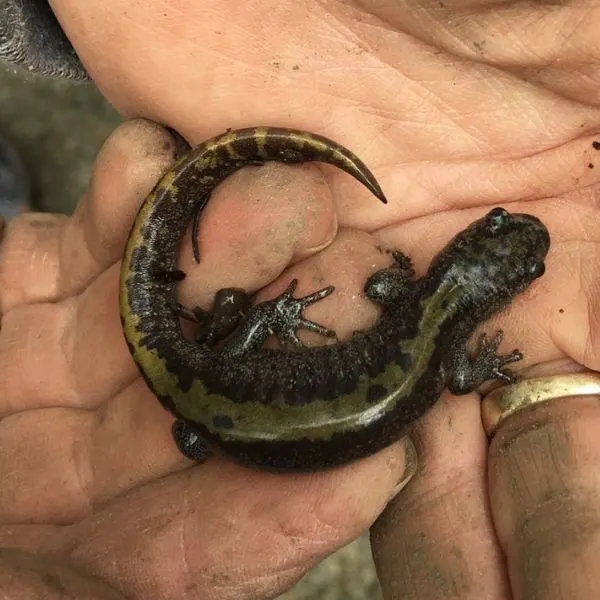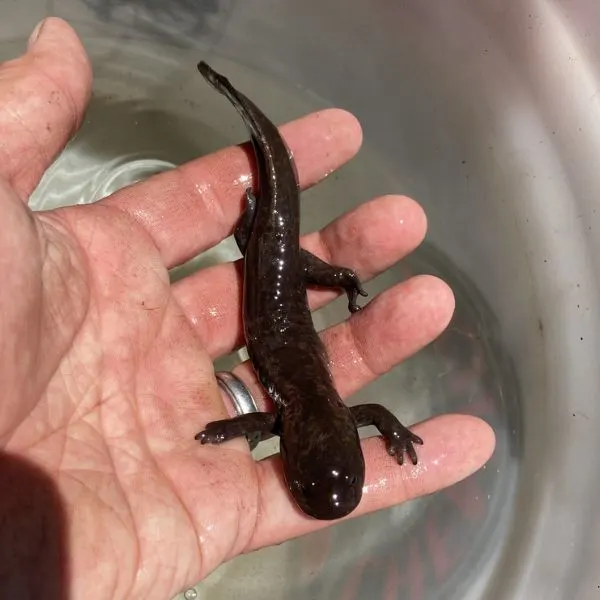There are four species of salamanders in Montana. Thanks to its natural landscape includes river valleys, forests, grasslands, caves, and canyon habitats the state is a great place for herping, housing 14 amphibians, and 20 reptile species in total.
Salamanders are an important part of Montana’s ecosystem since they are used as food by animals like other amphibians, fish, birds, larger reptiles, and meat-eating mammals. Like other amphibians within the U.S., some of the salamanders in Montana are facing depopulation. Pollution in the waters they live and breed in is one of the causes, which is why finding a strong population of salamanders is a sign of a healthy ecosystem.
Let’s take a look at the four salamanders in Montana, and the important things that you should know about them.
Table of Contents
Salamanders in Montana
1. Western Tiger Salamander

- Experience Level: Intermediate
- Family: Ambystomatidae
- Scientific Name: Ambystoma mavortium
- Other Names: Yellow-Barred Tiger Salamander
- Adult Size: 6 to 13 inches (15.24 to 33 cm)
- Lifespan: 15 years
- Average Price Range: $80
The western tiger salamander is a native species to Montana. They live in the majority of the state but are absent from the western regions of Montana. Western tiger salamanders live in agricultural, and prairie habitats near ponds, springs, and lakes. Adults spend their time underground in self-made burrows or overtake ones made by a rodent.
Tiger salamanders are one of the largest salamander species in Montana and have robust bodies. Adults have dark brown coloring, with yellowish, tan, or green blotches that appear on them. Compared to other tiger salamanders this species has more elongated blotches.
The spring after the snow melts is when this species breeds. They lay their eggs in clusters of around 5 to 120 eggs, attaching them to vegetation. Tiger salamanders like other members in the Ambystomaatidae family attempt to return to their birthing waters to mate. Hatchlings are aquatic and have feather gills that help them breathe. Tigers salamander’s aquatic stage tends to last for around 2.5 to 5 months.
The large size of this species allows them to feed on larger amphibians. Insects, spiders, worms, slugs, and other invertebrates are what this species feeds on most. They are preyed on by animals like owls, badgers, and snakes.
2. Northern Long-toed Salamander

- Experience Level: Intermediate
- Family: Ambystoma
- Scientific Name: Ambystoma macrodactylum krausei
- Other Names: Eastern Long-toed Salamander
- Adult Size: 2.13 to 3.5 inches (4.1 to 8.9 cm)
- Lifespan: 6 to 10 years
- Average Price Range: $25
The Northern long-toed salamander is a subspecies of salamander that lives in Montana. This species lives within the western region of the state, and is common. Long-toed salamanders inhabit the far west of North America. Meadows, woodlands, and mountainous habitats up to 9,000 ft. above sea level are where this species lives.
The long-toed salamander has black coloring, with a dusky mottled appearance. A tan, yellow, or greenish dorsal stripe runs down their back, and light-colored specks of white or pale blue appear on their sides. This species has a dark brown belly covered in white specks. Northern long-toed salamanders are a medium-sized species, and they have 12 costal grooves on them. Their name comes from their elongated back toes.
Northern long-toed salamanders breed from fall to spring. Species at higher elevations breed from early spring to summer. Long-toed salamanders are explosive breeders, coming to water sites in heavy rain. Females lay up to 264 eggs, placing them in a gelatinous substance for protection. Larvae are aquatic, and usually complete metamorphosis by summer.
Northern long-toed salamanders feed on insects, slugs, crickets, and worms. They eat anything small enough that fits into their mouths. Garter snakes, small mammals, fish, and birds are the predators of this species.
3. Idaho Giant Salamander

- Experience Level: Intermediate
- Family: Ambystomatidae
- Scientific Name: Dicamptodon aterrimus
- Other Names: n/a
- Adult Size: 7 to 13 inches (17.78 to 33.02 cm)
- Lifespan: 6 to 10 years
- Average Price Range: n/a
The Idaho giant salamander is found in a small region within Montana near the Idaho border. This species is mainly found in the forest areas near the Coeur d’Alene to Salmon Rivers. They are aquatic when born. They leave the water once they become terrestrial after 18 to 24 months after being born.
Idaho giant salamanders are the largest species of salamander in Montana, and their size is their most identifying trait. They have tan or copper coloring with a dark mottled pattern on them. This species does not have visible costal grooves and has a very chunky body.
Females when breeding usually lay between 135 to 200 eggs, placing them in streams. Larvae feed on insects, frogs, fish, and other salamanders. Adults are nocturnal, and may not be seen often since they hide under debris like rocks, or in vegetation. Adults are able to feed on animals like other frogs, insects, mice, and small snakes because of their size.
Biting, toxic secretions, and marking a “bark” sound is how this species defends itself from predators like shrews, weasels, and large snakes. Their bites can pierce human skin, but this salamander is typically harmless. Idaho giant salamanders have a small range, and their populations in their overall range are considered at risk for vulnerability.
4. Coeur d’Alene Salamander

- Experience Level: Intermediate
- Family: Plethodontidae
- Scientific Name: Plethodon idahoensis
- Other Names: n/a
- Adult Size: 2 to 4 inches (5 to 10 cm)
- Lifespan: 13 years
- Average Price Range: n/a
A native species to Montana, the Coeur d’Alene salamander is only found in the far western region of the state. This species lives in woodland habitats, near water sources. In Montana, this species is listed as one of Special Concern since they have a limited range, and few studies have been done on their populations in the wild.
The Coeur d’Alene salamander has a slender appearance and is one of the smallest salamander species in the state. They have dark brown coloring, with a yellowish dorsal stripe on them. Under their throat are yellow patches, and they have light-colored specks on their sides. This species looks similar to the long-toed salamander, but their shorter toes can distinguish the two.
From June to September this species is not active because of the heat. They become inactive again in the cold period after November, coming out in the spring. Coeur d’Alene salamanders are nocturnal. Insects and invertebrates are what this species eats during the night.
FAQ
What is the largest salamander species in Montana?
The Idaho Giant Salamander is the largest salamander species that lives in Montana. This native giant can get up to 13 inches large, but on average weigh between 4.5 to 6 inches.
Idaho Giant salamanders are a species in the state that is of special concern, since they have a limited population, and are only found in a small area of the state along the western border near Idaho.
Are the salamanders in Montana dangerous?
Salamanders like other amphibians release toxins from their secrete, but these secretions are mainly meant to keep themselves moist.
Most salamanders do not have strong enough toxins to be poisonous, but they can leave a foul taste in a predator’s mouth. Newts typically have the strongest toxins, and the level of toxicity of a salamander depends on the species.
In general, you should avoid picking up a salamander since their permeable skin can take in potentially dangerous waste from our hands. The salamanders in Montana are not very poisonous, and humans are more dangerous to them than they are to us.
Where are salamanders most common in Montana?
Salamanders usually inhabit areas near freshwater sources like ponds, lakes, or springs. Some use these waters to breed and live in while others are primarily terrestrial.
Each species has its own preference for where it prefers to live, and when young some species spend their early years in the water. Salamanders are nocturnal, coming out often during the rainy season. They are secretive animals that hide under debris like rocks, logs, and in leaf litter.
Wrapping up
Montana may only have four salamanders in the state, but they are all very important to the environment. Salamanders that are endangered are mainly affected by diseases, climate change, pollution in waters, and the degradation of their habitats. Montana’s few species need to be protected, as they are an essential aspect of Montana’s ecosystem.
Out of all the species of salamander in Montana, the tiger salamander likely makes for the best pet because of its sturdiness, and large size. You should never take a salamander from the wild since they are needed to sustain the populations in the wild. Salamanders that come from the wild also can die quickly since they are prone to diseases, and parasites.
Salamanders in Montana are easier to find if you know where to look and know when they are active most. It is always fun to go out into the wild and find the amazing wildlife near you.
Other nearby states
